*This course has been retired. There is no replacement course at this time. Please click here to view the current ATrain course listings.
There are three kinds of influenza: A, B, and C. Influenza B and C aren’t much to worry about, at most causing minor illness. The influenza A viruses, by contrast, are highly variable and so have the potential to outwit the human immune system and cause a pandemic.
Henry Nicholls
Pandemic Influenza: The Inside Story
It is helpful to understand a little bit about the influenza virus—the different types, how they are named, and how they mutate. The more you know, the better you will be able to protect your patients, friends, and family members from catching the flu.
Influenza viruses are categorized and named by type. There are three types of influenza viruses—A, B, and C. Type is determined by the material within the nucleus of the virus.

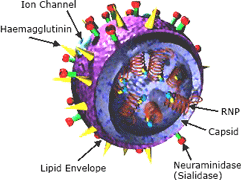
Left: The influenza virus. Copyright Zygote Media Group. Used with Permission. Right: Structure of the influenza virion. The hemagglutinin (HA) and neuraminidase (NA) proteins are shown on the surface of the particle. The viral RNAs that make up the genome are shown as red coils inside the particle and bound to ribonuclear proteins (RNPs). Source: NIH, public domain.
The nomenclature used to describe a specific influenza virus was established by the World Health Organization in 1980 and is expressed in this order:
- Virus type,
- Geographic site where the virus was first isolated,
- Strain or lineage number,
- Year of isolation, and
- Virus protein antigen subtype described by letter and number, H1 to H16 and N1 to N9 (CDC, 2015PB)
For example, the 2009 H1N1 pandemic influenza virus was named as follows:
A/California/04/2009 (H1N1)
This is translated as: Influenza type A, isolated first in California, lineage (strain) number 04, year 2009, and type H1N1.
In the image below, a Fujian influenza virus that circulated in 2002 was named as follows:
A/Fujian/411/2002 (H3N2)
This is translated as: Influenza type A, first isolated in Fujian (a province on the Southeast coast of mainland China), lineage number 411, year 2002, type H3N2.
Influenza Virus Nomenclature
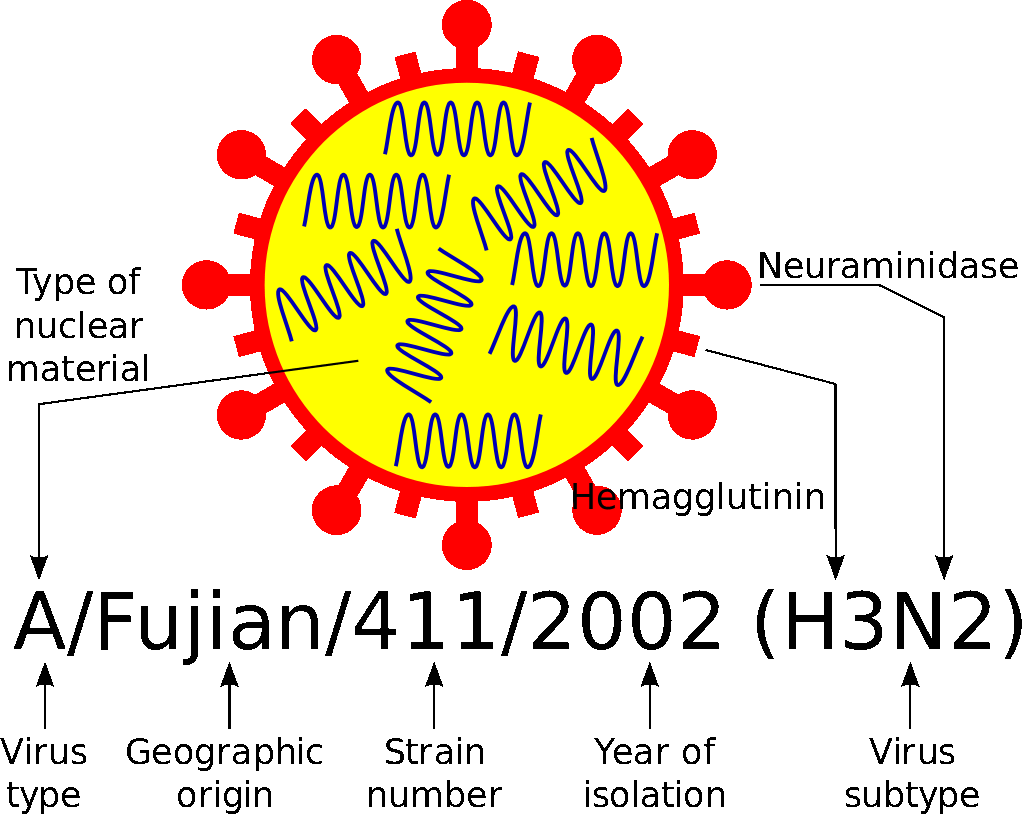
Influenza virus nomenclature (for a Fujian flu virus). Source: Wikipedia.org
The Fujian H3N2 influenza of 2002 caused an unusually severe 2003–2004 flu season, partly because it spread rapidly and partly because the vaccine for that season had already been formulated when the Fujian H3N2 virus was identified.
Type A Influenza and Its Subtypes
Type A influenza viruses are divided into subtypes, based on the presence of two glycoproteins on the surface of the virus. These glycoproteins are called hemagglutinin (HA) and neuraminidase (NA). About 18 hemagglutinins have been identified, although generally, only H1, H2, and H3 are found in human influenza viruses. There are more than 100 types of neuraminidase, but only N1 and N2 have been positively linked to influenza epidemics in humans.
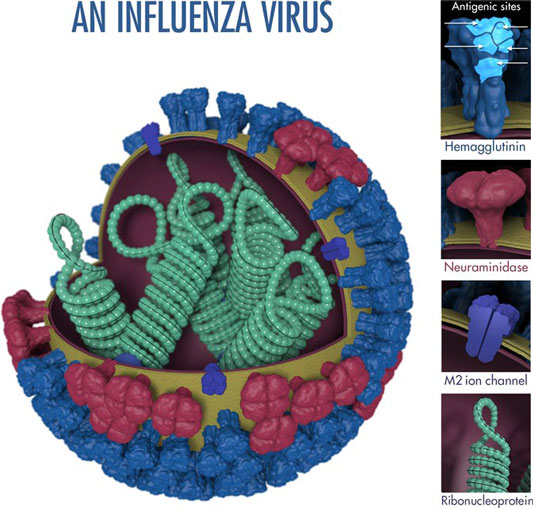
The above image shows the features of an influenza virus, including the surface proteins hemagglutinin (HA) and neuraminidase (NA). Following influenza infection or receipt of the influenza vaccine, the body’s immune system develops antibodies that recognize and bind to “antigenic sites,” which are regions found on an influenza virus’s surface proteins. By binding to these antigenic sites, antibodies neutralize flu viruses and prevent them from causing further infection. Source: CDC.
Hemagglutinin and neuraminidase are also called antigens, substances that, when introduced into the body, stimulate the production of an antibody. Currently, there are two subtypes of influenza A viruses found circulating among human populations: influenza A (H1N1) and influenza A (H3N2).
Wild Birds Provide the Usual Reservoirs
A reservoir is the place where a pathogen lives and survives. For all subtypes of influenza A viruses, wild birds are the primary natural reservoir and are thought to be the source of influenza A viruses in all other animals. Influenza A viruses are found in many different animals, including ducks, chickens, pigs, whales, horses, and seals.
Most influenza viruses cause asymptomatic or mild infection in birds; however, clinical signs in birds vary greatly depending on the virus. Infection with certain avian influenza A viruses (for example, some H5 and H7 viruses) can cause widespread, severe disease and death among some species of birds (CDC, 2018a).
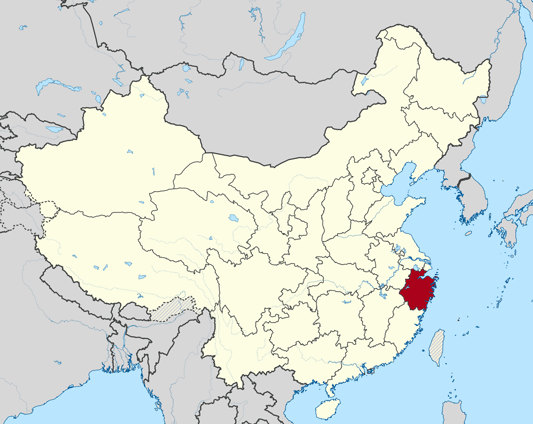
Zhejiang province, China (in red). Shanghai, a city with a population of 24 million, is located on the northern tip of Zhejiang province. Source: Uwe Dedering, Wikipedia Commons.
In 2013 the ability to quickly identify the reservoir of a novel avian influenza A (H7N9) virus helped Chinese officials contain what started as an outbreak of “pneumonia of unknown cause” in the eastern coastal province of Zhejiang, China. During the outbreak, there were 135 confirmed human infections with H7N9, the vast majority during the month of April. Many of the people infected with H7N9 reported contact with poultry. By August 2013, 45 people had died (Chen et al., 2013). The H7N9 virus had previously been detected in birds but had never been seen in humans or any other animals prior to this outbreak.
Annual epidemics of sporadic human infections with Asian-lineage avian influenza A (H7N9) virus (“Asian H7N9”) in China have been reported since March 2013. In late 2016, China experienced its fifth epidemic of Asian H7N9 human infections. This was the largest annual epidemic to date. As of September 13, 2017, the World Health Organization reported 764 human infections with Asian H7N9 virus during the fifth epidemic. During epidemics one through four, about 40% of people confirmed with Asian H7N9 virus infection died (CDC, 2018a).
Genetic Evolution of H7N9 Virus in China, 2013
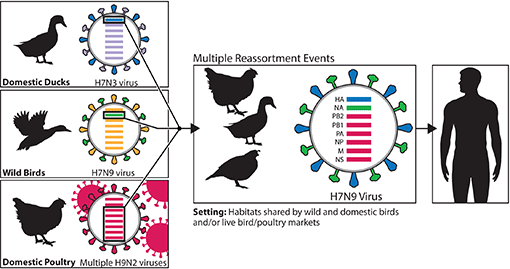
The eight genes of the H7N9 virus are closely related to avian influenza viruses found in domestic ducks, wild birds, and domestic poultry in Asia. The virus likely emerged from “reassortment,” a process in which two or more influenza viruses co-infect a single host and exchange genes. This can result in the creation of a new influenza virus. Source: CDC, 2014.
Type A Influenza Viruses Circulate in Pigs
Pigs are susceptible to avian, human, and swine flu viruses and can potentially be infected with influenza viruses from different species at the same time. If this happens, it is possible for the genes of these viruses to mix (reassort) and create a new virus.
Influenza viruses that normally circulate in pigs are called “variant” viruses when they are found in people and denoted with a letter “v.” H3N2v viruses from the 2009 H1N1 pandemic virus were first detected in people in 2011 and were responsible for a multi-state outbreak in the summer of 2012 that resulted in 306 cases, including 16 hospitalizations and 1 fatality (CDC, 2019j).
Most cases of H3N2v identified during 2012 were associated with exposure to pigs at agricultural fairs. Many fairs have swine barns where pigs from different places come in close contact with each other and with people. These venues may allow the spread of influenza viruses both among pigs and between pigs and people. Infected pigs can spread influenza viruses even if they are not symptomatic. Although instances of limited person-to-person spread of this virus have been identified in the past, sustained or community-wide transmission of H3N2v has not occurred (CDC, 2019j).
Type B Influenza
Influenza type B viruses are separated into two genetic lineages (B/Yamagata and B/Victoria). They are not classified by subtype like influenza A viruses. Influenza B viruses from both the Yamagata and Victoria lineages have co-circulated in most recent influenza seasons. The trivalent influenza vaccines available in recent seasons have contained one influenza B virus, representing only the Yamagata lineage. The quadrivalent vaccine for 2019–2020 will contain both the Yamagata and Victoria lineages (CDC, 2019f).
Influenza type B viruses are usually found only in humans, and can cause morbidity and mortality among humans, but in general are associated with less severe epidemics than influenza A viruses. Although influenza type B viruses can cause human epidemics, they have not caused pandemics. Influenza B viruses undergo genetic changes less rapidly than influenza A viruses.
Type C Influenza
Influenza type C is less common and less studied than influenza A and B. It can cause illness in humans and pigs, and it is thought that most people are exposed to influenza C during childhood. The influenza C virus lacks the multiple subtypes (hemagglutinin and neuraminidase) found in influenza A, which limits its ability to mutate. Influenza C is thought to be unlikely to cause a pandemic, although localized epidemics have occurred. As with type B influenza viruses, type C influenza viruses are not classified according to subtype.
Types of Influenza Virus | |
|---|---|
Influenza type | Characteristics |
Type A |
|
Type B |
|
Type C |
|
